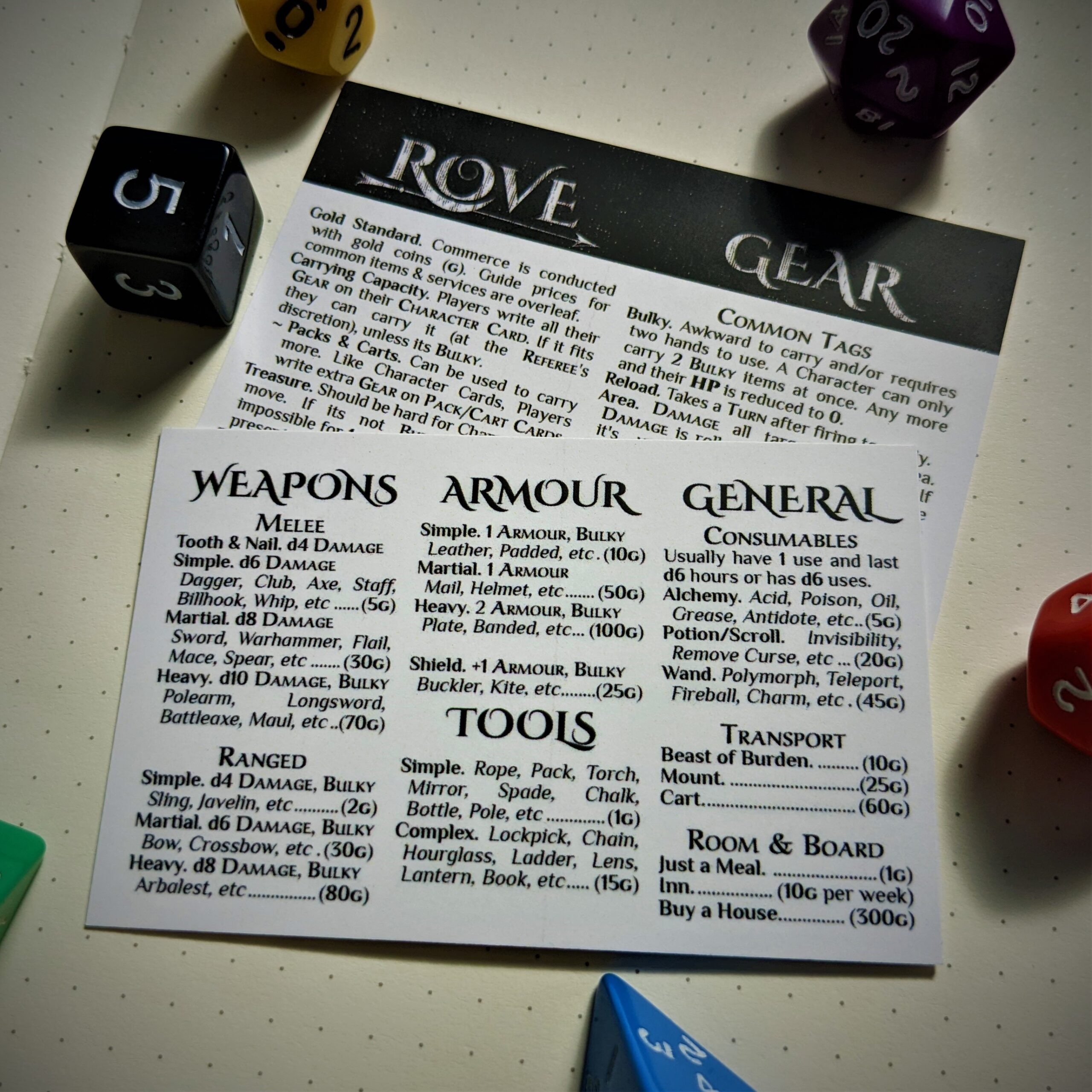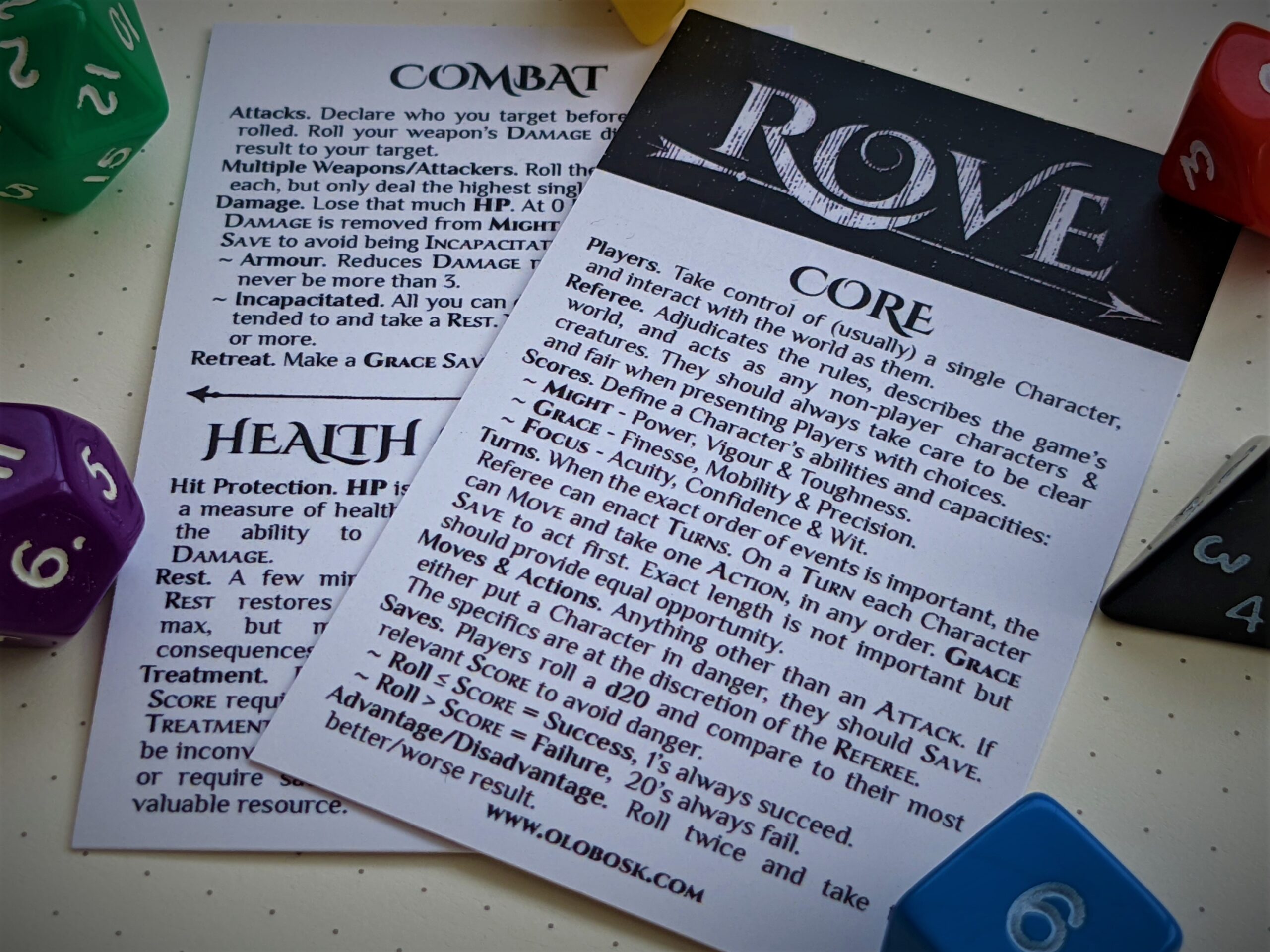Rove Devlog #3 – What is an Enemy?
This next card was difficult to design. It’s been the most difficult one so far to condense into two sides of a business card, yet perhaps has resulted in the one with the most “at the table” utility.
Enemies, or opponents, encounters – Monsters – are one of the core pillars of OD&D and the majority of all TTRPGs since. They make up a good portion of the content in a typical session.
Most TTRPGS provide you with a good list of them to pull from, or rely on adventures and supplements to provide them. I think Rove ultimately will do this too, but I wanted to provide a Referee with the mechanical stuffing necessary to run them in as best I could.
My goal with this card when I set out was to create a list of example monsters, some of your generic fantasy creatures, to illustrate what to aim for. Here are my 3 tiers of basic beasty I came up with initially:
Skeleton
4 HP, Rusty Sword (d4)Dusty bones held together by ancient curses, covered in the tattered remains of what it was buried in. Hobbles menacingly toward any living creature, envious of what it lacks.
- Paralysing Glare: Focus Save or reduce Grace to 0 for d6 Turns.
Orc
15 Might, 12 HP, 1 Armour, Serrated Blade (d8, Bleed)A hulking brute of greenish grey skin, fitted with battle scarred scalemail. They only respect strength, using intimidation and violence until put in their place by a more powerful foe. Is ultimately a coward.
- Bleed: After causing Damage, victim takes 1 Might Damage per Turn until the wound can be treated
Dragon
20 Might, 15 Grace, 15 Focus, 24 HP, 1 Armour, Teeth & Claws (d10), Fire Breath (d8, Blast)An enormous winged lizard, bright red scales and gnarled spikes cover its serpentine body. Covets its vast hoard of gold and jewels hidden in its lair. Intelligent, vain, manipulative and above all rapacious.
- Swallow Whole: Grace Save or be consumed in a single bite. Take d6 Damage from stomach acid each Turn. If not rescued within 4 Turns, suffocate.
I think doing this helped define in my mind what an Enemy is in Rove. So I produced an actual template:
[Might] Might, [Grace] Grace, [Focus] Focus, [HP] HP, [Armour] Armour, Weapon/Ability ([Damage])[Motivation]
- Ability: [Ability]
Ultimately this let me break down how I design monsters into 5 key aspects; Stats, Survivability, Damage, Motive and Abilities.
The first three are fairly basic, but require some fine-tune balancing to make them fun and easy to use in the system. These are effectively what dictate the challenge of the enemy.
Bigger number mean badder foe, mix to your liking.
This is kind of my philosophy for all RPG combat. These numbers are largely arbitrary but understanding what each does to a combat encounter is key to providing appropriate challenges to a party of players.
Stats are effectively resistances to Player abilities/machinations/etc. The exact flavour of Stat can give a sense of weaknesses/strength and provide some opportunity for Players to plan and optimise their strategy to exploit/avoid them. I am always wary about making these numbers high however. They only add opportunities to say no to your Players or deny them opportunities to shine. They should be used judiciously to give a sense of fairness or verisimilitude.
HP/Armour only serve to either elongate or hasten combat. The bigger the numbers, the more rounds of combat there will be. With the variance in player HP/Armour and Damage output, it can never be an exact science, but its the dial you play with. The distinction between HP and Armour is largely of taste, but large HP can give Players a sense of size whereas Armour more of a sense of “unstoppability”. Sort of. It’s definitely subtle and in reality just gives a Referee something to anchor mid-battle descriptions off of.
Damage also serves as a timer to combat, but more importantly, it serves as punishment for poor planning and decisions. This is how a Referee maims and kills the Characters. Bear that in mind when making these numbers high.
Then we get to the interesting aspects. The things that truly distinguish enemies in the fiction of the game.
Motive I truly think is the core of any good enemy design. A good motive and random stats trumps intricate balanced stats and no motivation every time. The motive provides the Referee with everything they need to run the enemy. Knowing what drives it, lets you extrapolate to any action they might take, often without too much imagination or real thinking. The closest TTRPGs have to NPC AI.
Finally Abilities. This is what makes enemy design and running fun. Cool things for them to do not only helps distinguish one encounter from another, but provides endless opportunities for thematic reinforcement and tactical challenge.
So what does this mean for the Rove card?
Well I tried fervently to turn all this into a series of nested tables. I broke down every type of ability I could think of into its core components. I think I actually did a fairly good job. However, tables are terribly inefficient with space, and in Rove, space is my main limitation. So I scrapped the confusing nested tables with my frankly inscrutable notation system for a much more straightforward list of ability types to add challenge to an Enemy. The tables did survive in the form of my tiered challenge table to help guide the Referee when picking numbers.
Vulnerabilities naturally evolved from thinking about the opposite of abilities. If you can increase an Enemies potential challenge, you can also decrease it.
The result
The first side was a more straightforward rules reference, pulled pretty much entirely from Trash Planet.

The second I am much more proud of.

Here I crammed as many examples of what I mean in as possible, so in theory you could pick from these lists to construct a perfectly feasible beasty from these alone.
I by no means think these lists are exhaustive, but they are pretty comprehensive. I have already had a lot of success keeping this card on me when I run any RPG now. It serves as great inspiration when I need a quick random encounter.
If there is any card I am particularly keen to hear feedback on, it’s this. So if you do use it, be sure to let me know!
That’s it for this time. Catch you for the next one.
Olobosk.


















